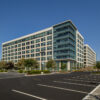Let’s take a deep dive into the trends shaping commercial real estate investing as we head into 2023. As the commercial real estate market continues to see ongoing changes, investors, owners, and operators in the space are having to deal with new challenges. The ever-changing workplace, labor shortages, sustainability motives, and increased interest rates all play major factors in today’s market.
While there will always be challenges for investors to face, there will also be newfound opportunity for CRE investors in 2023. Let’s take a look at the top trends shaping and changing commercial real estate investing today.
Commercial Real Estate Outlook for 2023
Before we dive into the trends shaping commercial real estate, it can help to lay out the industry’s current standing. Here are a few figures from recent reports to put the market’s current state into perspective:
- Federal Reserve has recently stated rate hikes will continue into mid-2023.
- Rental price growth expected to increase from 5.8% (June 2022) to 8.4% (May 2023).
- Reportedly, only 10% of CRE investors saw their portfolios decrease in 2022.
- 64% of property teams in the office segment will increase investments in proptech during 2023.
- 84% of property teams have tenants who’ve fully implemented the hybrid work model.
Multifamily Real Estate in 2023
So far in 2023, the demand for multifamily housing has remained strong. The high interest rates that first-time buyers are forced to deal with are leaving many investors thinking the demand for multifamily will hold pace throughout 2023.
Here are a few of the trends shaping the multifamily housing sector:
- Increasing demand throughout major metro areas across the U.S.
- Many undersupplied cities as far as total housing units is concerned
- Increased rent prices
- Increased construction costs and supply chain issues
Overall, the multifamily market is on the investors side right now. High demand paired with increases in rent prices make for attractive opportunity across the country, but it won’t come without difficulty. Many investors, builders, and developers are struggling to put together new projects as they face the same supply chain/construction issues that they’ve been dealing with since pre-Covid.
Sustainability for Commercial Real Estate
It should come as no surprise that sustainability will play a huge role in commercial real estate throughout 2023. Government – at both the federal and state level – is expected to pass both green building mandates and incentives towards sustainability that will directly impact the commercial real estate industry.
Here are a few numbers to help explain the sustainability impact on CRE:
- 61% of CRE property teams are prioritizing energy efficiency in 2023.
- 24% of CRE firms report being on the path toward net zero/carbon neutrality
- 49% of CRE firms are prioritizing sustainability on the technology front
While more and more regulation can certainly be expected when it comes to sustainable practices in commercial real estate, there are still ways investors can use sustainability to their advantage. Most notably, solar continues to be a priority in 2023. Solar offers CRE investors and property owners the ability to boost cash flow by reducing utility expenses, increasing rents, increasing maintenance reimbursements, and capitalize on certain tax credits.

Work-From-Home/Office Revival
The debate around the future of the white collar workforce has been touched on again and again since the pandemic inspired a surge of people to work from home. While many people have already returned to the office, there is still an estimated 26% of U.S. employees working remotely.
The work-from-home movement has led many developers in the office space to rethink strategy and build more incentivizing and accommodating workspaces. Many tech and finance companies with already established offices have had to make similar changes.
Despite the opposition from office workers, the office sector hasn’t experienced as big of a hit as you might think. Reportedly, no region across the U.S. has seen vacancy rates plunge below pre-pandemic levels. In the end, the investors and developers that cater to the office-workers needs and expectations will likely come out on top – something that’s already being proven with Phoenix’s The Grove, a 181,494 square foot innovative Class A space.
A Variable Retail Sector
As it has always been the case, the state of the retail market will largely depend on location and retail category. Neighborhood shopping centers outfitted with grocery stores, pharmacies, coffee shops, and attractive restaurants will continue to do well so long as they are located in well-populated and active residential areas.
Investors have tried to revive Class B and C retail spaces – mainly strip malls – for decades. While there are sometimes tax advantages in doing so, more and more investors and developers are repurposing these spaces altogether. One trend we can expect to continue throughout 2023 and 2024 is the recycling of these once dingy strip malls into more lucrative establishments. So far, developers have turned these Class B and C retail spaces into multifamily housing, attractive shopping centers, movie theaters, and more.
Commercial Real Estate Investment | Phoenix, Arizona
The commercial real estate market in Phoenix has seen monumental growth in the last two years. Investors have found high demand, low supply, unfathomable rent growth, and lucrative opportunity across the board. The metro area has grown to accommodate the city’s 4.6 million total residents with incredible job growth, job opportunity, and consumer spending. Certain suburbs saw a growth of over 80% in the last decade – not to mention the bustling industrial space either.
Here is an overview of the state of commercial real estate in Phoenix as of 2023:
- Multifamily: High demand bringing in more developers and investors; growth rate peaked at an impressive 27% in 2022.
- Industrial: Annual rent growth rate of 16.5%, nearly doubling the national average.
- Retail: Steadily increasing rents – 7.1% year-over-year, compared to the national average of only 4.3%.
- Office: Steady market despite troubling factors; 160 building transactions in 2022 with total investment sales volume of $2.2 billion.
More and more investors are turning to the Phoenix market for lucrative hedges against inflation and competitive overall opportunities. Looking to find out more about CRE opportunities in Phoenix? Feel free to reach out to us at ICRE Investing with any questions you might have!
















